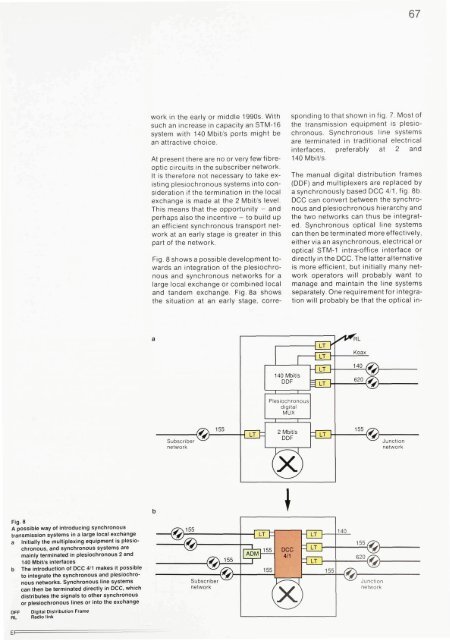Transport Network Development - ericssonhistory.com
Transport Network Development - ericssonhistory.com
Transport Network Development - ericssonhistory.com
- No tags were found...
Create successful ePaper yourself
Turn your PDF publications into a flip-book with our unique Google optimized e-Paper software.
67work in the early or middle 1990s. Withsuch an increase in capacity an STM-16system with 140 Mbit/s ports might bean attractive choice.At present there are no or very few fibreopticcircuits in the subscriber network.It is therefore not necessary to take existingplesiochronous systems into considerationif the termination in the localexchange is made at the 2 Mbit/s level.This means that the opportunity - andperhaps also the incentive - to build upan efficient synchronous transport networkat an early stage is greater in thispart of the network.Fig. 8 shows a possible development towardsan integration of the plesiochronousand synchronous networks for alarge local exchange or <strong>com</strong>bined localand tandem exchange. Fig. 8a showsthe situation at an early stage, correspondingto that shown in fig. 7. Most ofthe transmission equipment is plesiochronous.Synchronous line systemsare terminated in traditional electricalinterfaces, preferably at 2 and140 Mbit/s.The manual digital distribution frames(DDF) and multiplexers are replaced bya synchronously based DCC 4/1, fig 8b.DCC can convert between the synchronousand plesiochronous hierarchy andthe two networks can thus be integrated.Synchronous optical line systemscan then be terminated more effectively,either viaan asynchronous, electrical oroptical STM-1 intra-office interface ordirectly in the DCC. The latter alternativeis more efficient, but initially many networkoperators will probably want tomanage and maintain the line systemsseparately. One requirement for integrationwill probably be that the optical in-Fig. 8A possible way of introducing synchronoustransmission systems in a large local exchangea Initially the multiplexing equipment is plesiochronous,and synchronous systems aremainly terminated in plesiochronous 2 and140 Mbit/s interfacesb The introduction of DCC 4/1 makes it possibleto integrate the synchronous and plesiochronousnetworks. Synchronous line systemscan then be terminated directly in DCC, whichdistributes the signals to other synchronousor plesiochronous lines or into the exchangeDFFPLDigital Distribution FrameRadio link
















